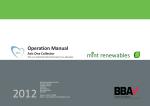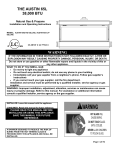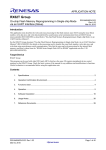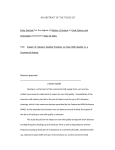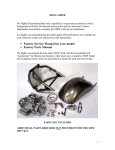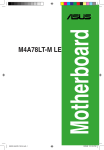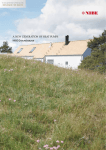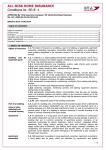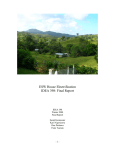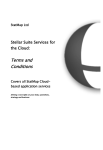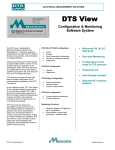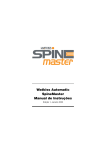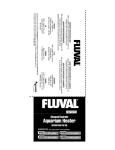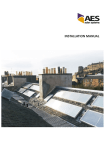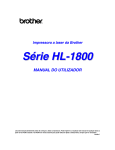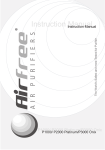Download E-tube System Manual - Telford Copper Cylinders
Transcript
mint E-tube Evacuated tube collector System Manual mint renewables Table of contents General Terms and Conditions............................................................ 3 Safety Precautions...............................................................................4 System Planning.................................................................................. 5 System Installation.............................................................................. 7 Installation Schematic......................................................................... 11 General Information............................................................................12 Design and Survey Report.....................................................................14 System Commissioning Checklist.........................................................16 Technical & Dimensions...................................................................... 18 Warranty & Solar Key Mark ................................................................19 General Terms and Conditions Installation and commissioning should be undertaken by an MCS Certified Solar Installer Company. General terms and conditions of warranty state that all installations must completed by a MCS certified and qualified solar installer company who is currently on the live MCS register of installers. Structure All installer companies should work to the Building Regulations in force at the time of installation.. The collectors may only be mounted on sufficiently loadbearing roof surfaces and substructures. The structural load- bearing capacity of the roof and the substructure must be assessed on- site, by a suitably experienced professional before mounting the collectors. The manufacturer’s warranty will only apply if these installation instructions are followed. The warranty does not cover any damage caused by non- observance of this manual. Particular attention should be paid to the quality of the timber substructure in terms of the stability of the screw joints necessary for installing the collectors. The correct functionality of the system is only guaranteed if the installation instructions are followed. In particular, it is essential to have the entire collector structure verified at the installation site by a qualified engineer in regions with high wind speeds. The end client should be informed at system handover that system should be checked visually once pre year and the heat exchange fluid changed once every four years. This document is part of the warranty and should be kept in a safe place and handed over to the end user client on completion of works. Instructions for installation and transport Mint Solar Collectors kits are delivered on pallets. Never store outside in water logged conditions. Always store on a flat surface with glass facing upwards maximum 8 collectors per stack., or vertical with glass facing outwards. The use of a carrying strap is recommended for transporting the collector. The collector must not be lifted at the connections. Avoidimpactsandmechanicalactionsonthesolarcollector. Mint Solar Collectors should only be used in professionally designed systems with all system components and materials being appropriately rated for use in solar water heating systems and properly installed. The assessment should also take into account any special features of the particular site that could lead to increased loads (high wind speeds, snow loads etc). Lightning protection / Potential bonding of the building It is not necessary to connect collector arrays to the lightning protection of the building (please observe the specific electrical regulations). For installations on metal substructures at the installation site, authorised lightning protection specialists must be consulted. The metal tubes of the solar circuit must be connected to the main potential equalization bus by means of a conductor (green/yellow) with a cross- section of at least 16mm² CU (H07V- U or R). It is possible to ground the collectors to a ground rod. The grounding line must be laid outside the house. The ground rod must also be connected to the main potential equalization bus by a line with the same crosssection as above. Connections (compression connection fittings) Connect the collectors using the certified solar compression connections supplied with your kit. Precautions must be taken to protect the connection pipes against temperature fluctuations caused by heat expansion (expansion bends/flexible piping). In this case, no more than 6 collectors may be connected in series. Larger collector arrays must be assembled with expansion bends or flexible members inserted in the links (IMPORTANT: check the pump design). When tightening the connections, always apply counter pressure with a wrench or another spanner to prevent damage to the manifold connections. Collector inclination / General notes The collector is suitable for installation at an angle of between 15° - 75° Steps must be taken to ensure that water and other contaminants such as dust, etc. are prevented from getting into the collector connections and ventilation holes. Warranty Warranty claims can only be made if an appropriate specification of antifreeze is used and maintenance is carried out correctly. Ladder and scaffolding assembly Safety Precautions Before commencing mounting work on roofs, it must be ensured in all cases that the non personal fall protection and fall- arrest systems required by DIN 18338 (Roof Covering and Roof Sealing Works) and DIN 18451 (Scaffolding Works) are in place. See also Builders’ Protection Ordinance If non- personal fall protection or fall- arrest systems cannot be installed for technical reasons, all personnel must be secured by means of suitable safety harnesses! Only use safety harnesses (safety belts, lanyards and straps, shock absorbers, fall arresters) that were tested and certified by authorized testing bodies. If non- personal fall protection or fall- arrest systems are not provided, working without the use of suitable safety harnesses may lead to falls from heights and therefore cause serious or lethal injuries! Ladders not properly secured against sinking in, sliding or falling over may lead to danger- ous falls! Whenever you are near live overhead electric cables where contact is possible, only work if: - it is ensured that they are voltage- free and this is secured for the duration of work. The live parts are secured by the ESB by covering them or cordoning them off. And are deemed safe by ESB transmission supervisor. Or advised safety distances are maintained. Voltage radius: 1m with .......................voltages up to 1000V 3m with ........voltages from 1000V to 11000V 4m with ......voltages from 11000V to 22000V 5m with ......voltages from 22000V to 38000V > 5m in case of unknown voltages The manufacturer hereby guarantees to take back products identified with an eco- label and to recycle the materials used. Only the heat transfer medium specified may be used! Safety harnesses should be fixed above the users whenever possible. Safety harnesses should only be fastened to sufficiently load bearing structures or fixing points! Never use damaged ladders (e.g., wooden ladders with split runners or rungs, or bent or buckled metal ladders). Never try to repair broken runners, rungs or steps on wooden Ladders! Ensure that ladders are put up safely. Ob- serve the correct leaning angle (68° - 75°). Prevent ladders from sliding, falling over or sinking into the ground (e.g. using wider feet, feet suited to the ground or hooking devices). Only lean ladders against secure points. Secure ladders in traffic areas by suitable Cordoning. Contact with live electric overhead cables can be lethal. Wear protective goggles when drilling and handling solar collectors evacuated tube collectors have a danger if damaged of implosion ! Wear safety shoes when carrying out installa- tion Work! Wear cut- proof safety gloves when mounting collectors and handling evacuated tube collectors (danger of implosion)! Wear a helmet Prior to installation Check the proposed collector siting is suitable. The collector is suitable for flat roof, tiled roof, cement and concrete roof structures. The installation should be carried out by able and qualified persons only. Its is the responsibility of the end user to adhere to local planning and conservation regulations. The collectors must be fixed only to a load bearing roof structure and substructures. A structural survey may be required to calculate the permitted load. Do not mount the collector if you are unsure the structure will carry the load. The location of the collector should be positioned at least 1 meter from any edge or ridge. A pre assessment of the location should take into account any additional factors that could lead to additional loads, ie, wind, air jets and snow. The collector arrays must be mounted in a way as to avoid snow piles reaching the collectors. Use the correct mountings. The collector can be sup- plied with the correct fixings for both slopping roof and flat roof types. Not using the recommended fixings as outlined in this manual will invalidate any warranty. Please note - metal straps are not a recommended method of fixing. Lightening protection Non metal structures Lightening protection is not required for collector arrays mounted to non metal structures, although it is recommended that protection diodes for the temperature sensors are installed. Lightening protection diodes protect the control unit from over voltage in the event of a lightening strike. Metal structures For installations mounted and fixed to metal structures a lightening protection specialist must be consulted. Connection of collectors in series The collector manifold inlet and outlet is 3/4” male. Soldering onto the collector manifold is not permitted and will invalidate any warranty claim. Connections can be of either copper tube or flexible metal pipe. When using copper tube precautions must be taken to account for temperature fluctuations caused by heat expansion. Do not connect more than 6 collectors (SZ10-20) or 4 collectors (SZ30) in series without the use of expansion connectors. a f Series c 72 g d < b The Heat pipe condenser can become very hot at the top end from diffused sun radiation (>200 °C). Therefore, the pipes should be covered before assembly and also to be protected against impact. With Transport and Handling the manifold upside down. Align the pre drilled holes on the front leg over the All Micoe SZ series collectors are packed in cartons, are easy to assemble and can be transported to the site before any assembly is required. Extreme caution should be adhered to when transporting evacuated tubes. Tubes are made from very strong glass, but will break if handled incorrectly. All cartons must be stored on a flat level surface. Cartons must not be stacked more than 5 high. Cartons must not be stored upright. Due to their weight and fragile nature two people are required to lift all cartons. Please dispose of all packaging sensibly. Cardboard can be recycled. Unscrew the tail stock end 1 cap. If this is done on the 7 roof care should be taken bolts attached to the manifold. to prevent it rolling off. Insert the two bolts on the Slide the tube through the tail manifold through the holes on 2 the leg. Secure them together stock up to the manifold. 8 Pull the heat pipe from the using 2x M8 nuts provided. glass tube to expose 200mm Repeat steps 1& 2 to Smear heat transfer paste mount the left & right leg Following this turn the 3 manifold right side up. evenly over the condenser 9 surface. Insert the condenser firmly into the manifold. Place the tail stock over the Apply a covering of soapy bottom of the legs. Align the 4 holes and secure tightly using 10 water onto the end 100mm of the glass tube x4 M8 nuts and bolts. Align the horizontal cross bars Using a twisting motion against the holes on the legs and attach securely using the 5 Solar collector carton contents a) Manifold 1x per collector b) Tail stock 1x per collector c) Front leg 2x per collector d) Horizontal bar As per collector e) Evacuated tubes As per collector +1 f) Anti dust circle 1x per tube opening g) Nuts / bolts Supplied quantity as per mounting h) Heat transfer paste 1x per collector h 11 M8 nuts and bolts. One seal per opening the manifold. Replace the end cap Insert the silicon sealing rings into the manifold openings. insert the tube firmly into 6 12 onto the tail stock. Repeat steps 7 - 12 for the remaining tubes It is advisable to mount the collector onto the roof &fill and flush the system (see page 7) before continuing to point 7 - installing the evacuated tubes System Please note the maximum allowable heat pipes in series is 90 = to ( 3*E-tube 30 modules) For high flow systems, the recommended flow rate for a heat pipe system is 60 litres/m2 /hour Descript Example 1 HP 65-30 =3.m2*60 = 180Ltr/hour Required Flow meter setting = 3 litre/minute Example 2 3*HP 65-30 =9m2*60 = 540Ltr/hour Required Flow meter setting = 9 litre/minute Large collector field flow rate calculations are dependent on layout design Example 3 (Low flow system) 6 *HP65-30 collectors mounted 3+3as diagram below 3*HP 6530 =9m2*60 = 540Ltr/hour Required Flow meter setting = 9 litre/minute 1 Roof hook 2 Collector pipe 3 Brackets 4 Base support 5 Side rails 6 T- or cross piece (6a, 7 6b) Screws M8 x 25 8 Wooden screw 9 Heat conductive 10 paste Manifold 11 Manifold case 12 Fitting for additional 13 collectors Sensor 14 pocket 15 Temperature sensor 16 De- aeration valve 17 Flexible metal tube 18 Tube holder Clamp Tile roof Natural slate roof Slate roof Corrugated sheet iron roof or slate roof Clamp for rolled steel joist Mounting and assembly Heat pipe Manifold Mechanical data Working pressure Recommended flow rate Manifold tails Max. 6bar 3.5 - 8 Litres/M²h 3/4” tapered thread Tube size 58mm x 1800mm Wall thickness of tube 1.8mm Glass material High quality borosilicate glass Vacuum tube QB-AL-N/AL metalic Stagnation Temperature 200.3°C Emission co-efficiency <0.06 for 80°C Solar absorptions 94% to 96% Heat output 69W per tube @ solar radiant intensity 1000w/m² Manifold Powder coated aluminium alloy Frame On Roof Mounting 1. Measure and mark out the position of the collector field 2. Remove roof tiles to expose rafter 3. Offer up bracket to rafter. Reinforce rafter with additional timbers to a width of 90 mm always bolt additional timbers Never nail. 4. Note bracket fixing position 5. Mark the tile underside with chalk and cut a 6- 8 mm groove to sit neatly over tile when re fixed to the roof 6. Repeat procedure for remaining brackets Mounting of additional roof hooks: Mount the other 3 roof hooks of the module in the same manner and ac cording to the measures. The hooks must be mounted horizontally and vertically in alignment. If necessary, mount further hooks for additional modules. 2 1 1 Tile mounting FIG 7 Select the rafters so that the collector juts out 30 cm at the right and left side. It is therefore recommended to measure first the distance of the rafters and determine a centre line before fitting in the collector. Start with roof hook - above left. Take out tile from rafter and screw roof hook to rafter with screws. Then replace tile to roof. Mounting of side rails: FIG 10 Screw the side rails at the roof hooks. Fixation of manifold case Slide manifold case with the profile rail into the hook of the side rail. Screw the bracket on the side bar. 3 3 Screw in additional grounds to 4 4 8 7 - 9 Locate and remove tiles where the roof 5 6 5 Ensure the roof bracket is fitted to the lowest point of the tile to assist drain off of rain from the roof. Relieve the rear of each roof tile with an angle 10 11 Free standing planning prior to deciding System Filling the system It is advisable to fill and flush the system prior to installing the evacuated tubes. If this is not possible cover over the tubes to block out the sunlight. The system should be filled with a glycol based antifreeze with anti corrosion inhibitors. Tap water must not be used. The system can be filled with a hand fill pump or a pressure fill pump and must be bled to eradicate any air bubbles from the solar circuit. Do not operate the air vent if the system is hot. There is a high risk of scalding. Only bleed the system if the temperature of the heat transfer fluid is less than 55°c Operating pressure Operating pressure 1.5bar cold. The maximum operating pressure is 6 bar. The maximum test pressure must not exceed 10 bar. Good tube Silver base. Vacuum present. Problem Low working performance from heat pipe solar collector Heat transfer media The system must be filled with a glycol based antifreeze with added corrosion inhibitors. The fluid must be checked once in every two years in respect to its antifreeze and ph value. Antifreeze is to be checked with a tester. The target value to be -20°c. If the target level is not reached, replace the heat transfer fluid. Ph levels are to be checked with a pH indicator rod. The target value to be pH7.5. If the target level is not reached, replace the heat transfer fluid. Temperature sensor The collector has a built in sensor sleeve. If there are two or more collectors mounted in series the sensor is to be inserted into the collector sleeve nearest the return flow back to the hot water store. Optimal contact can be achieved between the manifold and sensor by way of smearing the sensor with heat paste prior to insertion. An optional lightening protection device can be istalled to protect the sensor from over voltage. Maintenance The collector and arrays must be checked periodically. An annual close up inspection must be performed to check for damage, leaks, contamination and tube failures. Cause Remedy a) less solar isolation in you Calculate correct collector size & adjust accordingly, or install additional heat source. i.e. Gas boiler. b) solar collector is shaded from sunlight. Where possible re- move source of shade or relocate collector. c) Failed vacuum tube Replace failed vac- uum tube with new. d) Poorly installed heat pipe Refit the heat pipe. Apply heat paste to condenser surface. e) Incorrect instal- lation angle Reposition collector to an angle 51° +/- 10% (UK only) f) High heat loss due to poorly insulated pipe lines. Insulate all pipes with high tempera- Wind load on roofs can create suction forces on the solar collectors. In order to minimize suction forces, the mounting frame must be installed as follows. The subsurface must be sufficiently sustainable and appropriate for the weights to be installed. Upon it is therefore important to verify in advance that the roof structure is suitable to withstand the distributed load. If the mounting frame will not be connected with the subsurface (structure, roof sub-construction), a loading of at least 200 kg per collector is required (see fig 1). Additionally, the mounting frame can be connected with wire ropes at fixed hold points. Support elements and fasteners must be provided by the installer. Moreover, in order to avoid wind noise to a large extent, the mounting frame must be installed at least 1 m from the roof edge. In areas with high wind speed or high construction heights, the loading must be calculated by a structural engineer. Please refer to lightning protection and bonding to the structure. Installation of the mounting frame on large open surfaces of galvanised or trapezoidal sheet roofs. This types of installation should be specified only by a qualified structural engineer in accordance with current building regulations for such roofs. The frame can be bolted through these roof structures using oversized washers and rubber grommets to seal the roof however the sheets mustbe loaded with pebbles or substrate to equivalent weight. Free standing planning prior to deciding Mounting Wind load on roofs can create suction forces on the solar collectors. In order to minimize suction forces, the mounting frame must be installed as follows. The subsurface must be sufficiently sustainable and appropriate for the weights to be installed. Upon it is therefore important to verify in advance that the roof structure is suitable to withstand the distributed load. If the mounting frame will not be connected with the subsurface (structure, roof sub-construction), a loading of at least 200 kg per collector is required (see fig 1). Additionally, the mounting frame can be connected with wire ropes at fixed hold points. Support elements and fasteners must be provided by the installer. Moreover, in order to avoid wind noise to a large extent, the mounting frame must be installed at least 1 m from the roof edge. In areas with high wind speed or high construction heights, the loading must be calculated by a structural engineer. Please refer to lightning protection and bonding to the structure. Installation of the mounting frame on large open surfaces of galvanised or trapezoidal sheet roofs. This types of installation should be specified only by a qualified structural engineer in accordance with current building regulations for such roofs. The frame can be bolted through these roof structures using oversized washers and rubber grommets to seal the roof however the sheets must be loaded with pebbles or substrate to equivalent weight as in figure 1 Fig 1 Loading per collector The collector field can be mounted at different angles according to individual applications. For example larger systems used for heating support require a 60 degree angle in winter time , to maximise solar gain, this reduces the system efficiency in sum- mer when the system is not required for heating. Systems that require all year coverage such as hot water require 45 degree angle to maximise summer winter gain. Systems that are predominantly used in summer are most efficient at 30 degree angle. Install the profile rails in the in the pre drilled holes in the hypotenuse of the bracket insert the clamp and hanger brackets on the lower and upper profile rails mount the collector on the hanger brackets and clamp down each collector one at a time connecting the compression fittings to each collector as you install the next collector. System Installation Schematics Steca Wiring Connections Pump connections Live, Neutral, Earth T1 T2 Power connections Live, Neutral, Earth Refer to controller user manual for time, date, and system configuration set up General Installing the temperature sensor The solar collector temperature sensor should be installed in the sensor sleeve nearest to the collector array flow. To ensure optimal contact between the temperature sensor and the surrounding environment, the gap between the sensor sleeve and the sensor element should be filled with a suitable conducting compound. All materials used for installing temperature sensors (sensor element, conducting compound, cables, sealing and insulating materials ) must be suitably temperature resistant (up to 250oc). Operating pressure The maximum operating pressure is 10 bar. Removal of air from the system (bleeding) The system should be properly bled at commissioning to remove as much air as possible from the system. We would recommend that after 2 to 4 weeks of operation the system is bled again . Warning! - When bleeding the system there is a risk of scalding due to steam and hot transfer fluid and appropriate care must be taken. Only operate the bleeding valve if the temperature of the heat transfer fluid is below 60oc. When bleeding the system the collectors must not be hot! Cover the collectors and, if possible, bleed the system in the morning. Checking heat transfer fluid The heat transfer fluid must be checked at least every four years with regard to its antifreeze content and pH value. Check the antifreeze with an antifreeze tester and replace or refill if necessary. We would recommend a target protection of -25oc. Check the pH value with a pH indicator rod. If the limit pH value is less than 7.0 then replace the heat transfer fluid. Collector maintenance The solar collectors should be inspected visually, once a year, for any signs of damage, leaks or contamination. Design and survey report Date: Domestic hot water (DHW) 1. System type: Reference: Swimming pool heating Completed by: Surveyor contact no.: Client details: DHW plus space heating 2. Name: Building type (if house record whether detached, semidetached or terraced): House Block of flats Sheltered housing Commercial (describe) Address: ................... .................... Tel.: 3. Number of storeys .................... Mobile: 4. Approximate age of building .................... E-mail: 5. Is building listed? Yes/No 6. Is building in conservation area? Yes/No 7. Solar fraction: Low (circa 50%) Medium (circa 60%) High (circa 70%) 8. No. of occupants: 9. Approximate daily hot water usage (at 50oc) per occupant: Low (30 litres) Medium (50 litres) High (70 litres) Design and survey report (continued) 10. 11. 12. Type of fuel used for water heating (and approximate annual consumption in kWh) Hot water storage type Does property have combiboiler? 19. Gas ............kWh Oil ............kWh LPG ............kWh Electricty ............kWh Solid fuel ............kWh 20. Vented 21. Unvented Yes/No If yes, type: Available roof space Width Height up roof Any roof obstructions (e.g. Dormer, skylight, chimney stack) ..........................m ..........................m .............................. Please sketch the proposed location of the solar collectors relative to the roof plan of the building .............................. Pitched roof 13. Flat roof Proposed location for solar Ground mounted collectors Frame mounted on wall 14. 15. Roof orientation 16. Type of roof covering (eg. Slate, flat tile, pan-tile etc.) 17. 18. Roof condition Roof pitch Any shading (eg. none, from a tree, from a structure, part of the day, a lot of the day) 22. 23. 24. Are there any access restrictions for erecting scaffold? (if so, draw on sketch in 21) For pitched roof, collectors are to be: .............................. Mounted on-roof Roof-integrated Space for solar Height cylinder(s) in airing Width cupboard/plant room Depth ..........................m ..........................m ..........................m Design and survey report (continued) Volume 25. Proposed solar cylinder type Number of coils Additional information for swimming pools ....................litres ............................. 31. Pool dimensions Vented ............................. Width ............................. Average depth ............................. Indoors Unvented 32. Please note and special cylinder fittings required (e.g. shower fitting, pumped secondary fittings) ............................. 26. Proposed number of Asis One collectors ............................. 27. Proposed mounting configuration 28. Proposed solar circuit type 29. Approximate distance between proposed solar collector location and solar cylinder(s) ..........................m 26. Length Outdoors Pool location In-ground Above ground 33. Is a pool cover used when pool is not in use? Yes/No Portrait/vertical Gas Landscape/horizontal Oil Fully filled, pressurised 34. Drainback Type of fuel used to heat the pool LPG Electricity Solid fuel None 30. Please note recommendations for solar circuit pipe-route and note any complications or special features 35. ............................. If pool room (where appropriate) roof has not been described in 14 to 20, please provide dimensions and notes on structure System commissioning checklist: Customer details: Name: Commissioning date: Solar collector serial numbers Address: Telephone number: Mobile number: E-mail address: Installer details: Company name: Address: Telephone number: Mobile number: E-mail address: Web-site: MCS number: Solar collector mounting brackets and clips inspected and secure Solar collector connections inspected and properly fitted and tightened Type of weatherproofing of roof penetrations (for inlet and outlet pipe-work and sensor cable) ..................................... Penetration weatherproofing inspected and properly fitted Collector sensor probe securely fitted into collector sensor pocket Primary pressure limit of weakest component ................................bar System pressure when cold ................................bar Fuse rating for fused-spur supply to controller and pump ..................................... Controls and sensors checked and operating correctly ..................................0c System summary: Number of Asis One 1A collectors Type and volume of cylinder Type of pump-station and controller Type of solar circuit fitted ..................................0c Maximum cylinder temperature setting in controller ..................................0c Cylinder temperature sensors secured and sensor cable tied neatly Expansion vessel capacity ..............................litres Expansion vessel pre-charge pressure ................................bar System commissioning checklist (continued: Declaration (to be completed by the commissioning engineer): Volume of drain-back vessel (if drainback circuit): used) ..........................litres System flow-rate ...................litres/min Primary circuit volume ..........................litres Type of heat transfer fluid used ................................... I confirm that the system described in this commissioning checklist has been installed at the address stated. Earth bonding present The system design is in line with best practice and the system has been installed to comply with the Microgeneration Certification Scheme Standard MIS3001 and with all legal requirements. All notifiable works have been carried out by suitably qualified personnel and have been notified to the relevant authorities. Direction of non-return valve checked Signed: Position and type of air-vents used Air-vent(s) isolated after commissioning Type and thickness of insulation used ................................... Yes/No ................................... Pipe-work all insulated (apart from tee off to expansion vessel and air-vent) Pump operation and checked and pump running quietly Pump speed setting ................................... Method of anti-scalding in DHW circulation ................................... Location of fused isolation switch ................................... Location of pressure gauge ................................... System explained to customer System documentation provided to customer Date of commissioning: Print name: Evacuated tube heat pipe collector E-tube • On roof • Flat roof Heat Selective Coating Outer Tube E-tube evacuated tube heat pipe technology Silver Braised Header Inner Tube Our E-tube range of evacuated tubes are designed to offer excellent performance efficiencies at the most competitive prices possible for high quality evacuated tubes. The evacuated tube collectors use a vacuum space within each tube’s borosilicate glass shell to offer very high efficiency and heat loss protection in any climate. In the unlikely event of a tube breaking, it can be removed and the entire system will continue to function, ensuring a heating source that will not fail. There are three unique heat pipe evacuated tube models; E-tube 15 (15 tubes), E-tube 20 Ultra-high performance evacuated tubes Low profile contoured manifold Latest selective surface coating Silver brazed condenser riser head Solar keymark certified Multiple mounting and Internal Reflector Double wall Glass Tube E-tube 15 E-tube 20 E-tube 30 Zero loss collector efficiency 73.4% 73.4% 73.4% Heat loss coefficient 1.529 1.529 1.529 Overall area 2.42m2 3.18m2 4.70m2 Aperture area 1.40m2 1.87m2 2.79m2 E-tube technical data Length x width Max. operating pressure 1950mm x 1242mm 1950mm x 1632mm 1950mm x 2412mm 10 bar Glass Wool Insulation 10 bar 10 bar Warranty Conditions for Eco pipe Vacuum tube and flat plate collectors. All deliveries and services are carried out according to our general terms and conditions of sale. 1. The warranty period for the collector function amounts to 5 years for vacuum tubes and 10years for Manifold & plates. Within that period, all parts proven to be useless or considerably reduced in their usability due to production or material defects are repaired or replaced ex works, at expiration of the legal warranty period, we have the choice between rectification or replacement. 2. The warranty begins with the delivery of the collectors to the end user and under condition, that the system has been installed and setup by a specialised company according to our installation and operating instructions as well as the locally valid current building regulations. Further, the warranty is dependent on a carefully completed installation and maintenance record which must be filled out by the installer and kept by the system owner. 3. The guaranteeing implies that - The collectors are transported, installed, operated and maintained according to our installation and operating instructions, - the collector system is exclusively operated with our solar liquid. (or approved equivalent product) 4. The guaranteeing does not refer to damages due to- wear and tear , excessive wear, inappropriate operation or inappropriate use, - use of and unsuitable solar fluid or results of corrosion caused by a solar fluid, chemical or electro-chemical influences, incorrect system layout. 5. Moreover, the warranty does not apply for damages as a result of an inappropriate storage of the collectors prior to installation and damages that are ascribed to force adjure, The warranty regarding the safety glass refers to its condition, and here only to manufacturing and material defects. The cover security is examined in the context of the inspection requirements for collectors and ensured only according to these requirements. 6. The warranty expires - if arising and obvious defects are not notified in writing within 10 days after receipt or hidden defects immediately after emerging. In case of hidden defects it is only valid for the warranty exceeding the legal warranty period, - if the collectors are changed or maintained by not-specialised persons or companies or undertaken without or prior agreement, - if the possibility to inspect the entire system is not guaranteed or if the collector are removed without or agreement - if original components are exchanged by other components or if inappropriate installation material and system components as well as non authorized solar fluid are used, - if the annual inspection is not realized within the time limit. The proper execution is to be documented by the specialized company in the appropriate page is this manual 7. Transport damages are to be notified immediately, stipulated on the delivery note and signed by the subcontractor. 8. After the expiration of the legal warranty period, the warrantee must provide the necessary aid in case of reparation work and is obliged to assume the necessary services like transport, installation etc. In the event of warranty, we recompense - for on-roof installation max. 200,00€ + VAT for the first collector and max. 80,00€ + VAT for each additional collector, incl. All consumables. - for in-roof installation max. 300,00€ + VAT for the first collector and max. 90,00€ + VAT for each additional collector, incl. All consumables. 9. This warranty does not justify claims exceeding the legal liability for physical or personal injuries that have been caused by the defects of the purchased object. Retrospective actions and abatements exceeding legal regulations are not justified either. 10. Other legal claims for warranty and damages in respect of bad installation remain untouched by this warranty. 11. The exchange or rectification of the collectors or other parts of the solar system must be carried out by the installer and only after having consulted Eco pipe Otherwise an entitlement to compensation does not exist. 12. Notifications of claim are to be announced in writing to H2 Solar Shop Limited and by presenting the installation and maintenance record as well as the respective proofs immediately after the damage has occurred. 13. Solar accessories are subject to the warranty as specified by their Manufacturer. A reliable hand for expert advice and support 2012 Mint Renewables Limited 3 Kelham Court Kelham Street Doncaster DN1 3RF Tel: 01302 325000 Email - [email protected]





















